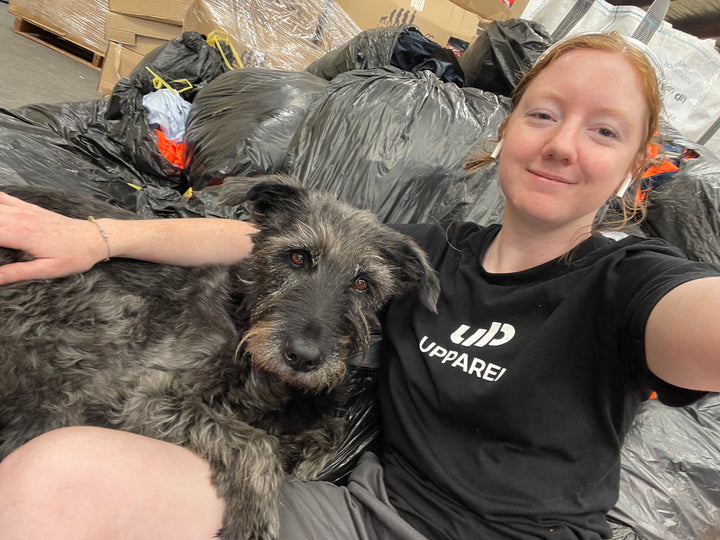
Ella Martin on resellers, charitable giving and upcycling!
by Charli Cox
·
From physically stewarding unwanted textiles at UPPAREL to donating time at our Tāmaki Makaurau pop-ups, Ella Martin clues us in on why resellers are a sign of a developing circular economy and her favourite thrift (so far) this year.
What does sustainable fashion mean to you?
Sustainable fashion, to me means clothing yourself in a way, which is driven by love and connection to the garments. It is actions with sincerity and intention. It means understanding where and who the clothing has come from and feeling that it can participate in your life for a long time, like a friend. When it gets damaged, you love it enough to mend it, and when it leaves your life, you care where it goes and what impact it makes.
Where do you think the responsibility lies to reduce the exploitative practices and environmental harm of the fashion industry? Who has the capacity to initiate the most change?
I think legislation holds the most meaningful and rapid power to initiate change. While conversations around personal responsibility must continue, it is too slow for the speed at which change needs to occur. Progress in this department has been slow in Aotearoa, but it is happening now, and we are fortunate to have international precedent to study in our next steps.
You’re also working at UPPAREL now!! Tell us about your role, the clothes nobody wanted, discarded for recycling and what they will become.
I am! I am privileged to work on the sorting and processing floor at UPPAREL, where we coordinate the incoming clothing, remove all hardware, sort into fibre groups and prepare for non-chemical recycling right here in Onehunga. Here, it gets shredded into a very fine FillUP fluff, where it can be manufactured into wadding or our UPtex boards for an endless range of uses. After my time in the fashion industry and waste minimisation, and as a certified Young Person with Climate Anxiety, I can’t overstate the satisfaction of physically stewarding unwanted textiles to their newUPcycled life.
The production of clothing is incredibly draining on the environment—fertilisers, toxic dyes, water usage, et cetera. In what ways can design processes and production methods alleviate these pressures?
Certainly, ultimately onshore production is a way to have more control and transparency around pollution, and also reduce the climate impacts that come with shipping. Ultimately, the most sustainable item is that which is used fully, so more efficient fabric lays can be achieved by designing garments backwards for a zero waste outcome. This is a slow and considered approach, which comes at a cost for the customer, who must appreciate this somewhat revolutionary approach to making clothing.
I also would love to see textile milling restart in Aotearoa, New Zealand because some of the worst pollution occurs during textile production, and we would have more control over this.
Greenwashing has come into sharp focus recently. How vital is language in shifting perception and encouraging re-use? An apt example of the power of language to relieve stigma is terming second-hand clothes as ‘vintage’ or ’pre-loved’.
Language is key! Something that has become clear is the way that language can be used either as a tool to transparently communicate a concept to a wider group or to obfuscate or totally gatekeep concepts to people. It can be too hard to educate yourself on every sustainability term. I appreciate the public campaigning to call out misuse of terms and clarify their meaning- because while the average person shouldn’t be denigrated for misunderstanding a term, a company certainly should know. In contrast, words can be used to promote inclusion in sustainable habits. I feel so optimistic about the way that the verbiage and perception around second hand items have been reframed to open these options up to all communities- as this is ultimately the circular economy that we need everyone to participate in.
What’s your best thrift of the year so far?
At a resellers market, I got a gorgeous black merino vest, which has become an instant staple. It can be hard to find great basics second hand, so I was stoked! Resellers are a controversial topic for how they source stock from op shops, but my bias is towards opening up the second hand market to the most people possible. Reselling businesses are a sign of a developing circular economy, and they reach people who are too busy to dig for what they need. And as you well know, there is currently so much second hand clothing going to landfill- so there is enough to go around.
And you volunteer with us! Do you have any more information about where the ‘donated’ garments go after they are handed over to us?
The first thing that happens when clothes are donated to Koha Apparel is that they pass through the hands of a team of passionate and kind volunteers. Every piece is assessed to ensure it is useful to the person who receives it. It then gets directly connected with communities at the local pop-ups throughout the country, with autonomous choice given to those who best understand their own needs. I love giving my time for Koha Apparel, because I know it is most effective in addressing the two key issues of clothing insecurity and rehoming good clothing. Couldn’t be more grateful.